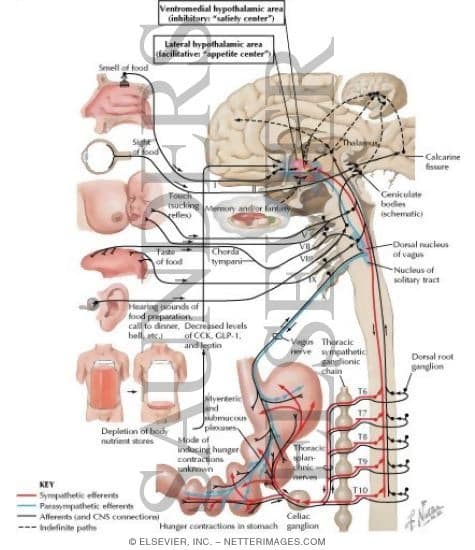- Signals that start and terminate a meal
- Hunger not triggered by empty stomach
- People with nerves cut to stomach or stomach surgically removed still reported feelings of hunger
- Sensors in hypothalamus and liver monitor blood glucose concentrations
- If glucose levels drop, liver converts stored nutrients back into glucose, producing a drop-rise glucose pattern
- Humans display a temporary drop-rise glucose pattern prior to experiencing hunger
- Walls of stomach and intestine stretch while eating, send nerve signals to brain to indicate fullness
- Nutritionally rich food can produce full feeling quicker than equal volume of less nutritious food
- Patients with removed stomachs can still experience satiety due to chemical signals
- CCK (cholecystokinin) released into blood after eating, stimulates receptors that decrease eating
- Hunger not triggered by empty stomach
- Signals that regulate general appetite and weight
- Fat cells secrete leptin (hormone that decreases appetite) to regulate food intake and weight
- Doesn’t directly cause fullness, but affects amount of satiety signals required
- Obese people have ample leptin in blood due to fat mass, but brain appears insensitive to signals
- Fat cells secrete leptin (hormone that decreases appetite) to regulate food intake and weight
- Brain mechanisms
- Many parts of brain play a role in regulating hunger and eating
- Lateral hypothalamus triggers hunger
- Ventromedial hypothalamus ends hunger
- Both found to not directly affect only hunger, but other factors that would also affect it
- Paraventricular nucleus (PVN) – cluster of neurons packed with receptor sites for various transmitters that stimulate or reduce appetite
- When losing weight, less leptin secreted, transmitters for hunger become more active (explains why dieting causes hunger)
- Many parts of brain play a role in regulating hunger and eating
- Eating is positively reinforced by the good taste of food and negatively reinforced by hunger reduction
- Beliefs about caloric content of food, and memory of when and how much we last ate also affect consumption
- Amnesia patients accepted multiple lunches half four after each other, while non-amnesia did not
- Attitudes, habits, and psychological needs also regulate intake
- Women overestimate how thin they must be to meet men’s standards, while men overestimated how bulky they must be
- Food availability is most obvious environmental regulator of eating
- Food taste and variety powerfully regulate eating
- Classical conditioning associates smell and sight of food with taste, triggering hunger
- Genes and environment
- Heredity influences basal metabolic rate and tendency to store energy as fat or lean tissue
- Genetic facots account for 40-70% of variation in body mass
- Experts believe obesity is due to abundance of inexpensive, tasty, high fat foods, a cultural emphasis on getting the best value (causing supersizing of menu items), and technological advances that decrease need for daily physical activity
- Dieting and weight loss
- Being fat alters body chemistry and energy expenditure, priming people to stay fat
- Obese people have higher insulin levels, which convert glucose to fat
- Being fat alters body chemistry and energy expenditure, priming people to stay fat
- Anorexia nervosa – eating disorder involving a severely restricted food intake
- Often perfectionists who strive to live up to lofty self-standards
- Bulimia nervosa – eating disorder involving binge eating followed by a purging of the food
- Often depressed and anxious, exhibit low impulse control, and lack a stable sense of personal identity and self-sufficiency
- Caused by environmental, psychological, and biological factors
- More common in industrialized countries in which beauty is equated with thinness
- Genetic factors may create a predisposition toward eating disorders
- Many researchers believe that physiological changes are a response to abnormal eating patterns
- Once started, the physiological changes perpetuate eating irregularities


